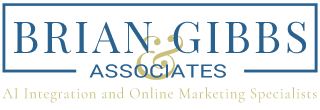Tips on Writing Copy That Attracts Your Ideal Client
"As a business owner, the best thing you can do to attract clients is writing a blog!" you hear it all the time. Then your heart begins to sink. I understand. Where do you even start? What is the best way to compose a blog post? So, I'm here to assist because good content is one of the best ways to keep clients coming back. In this post, I'll show you how I go about writing copy that will bring your ideal clients to your website.
Most people nowadays start hunting for your business with a simple internet search. Users rush to Google and other search engines to find that perfect match — a website they can understand quickly and a company that understands them. However, while having a professional-looking website is vital for grabbing a user's interest right away, it's just half of the equation for online success.
The best websites contain well-written, creative content that immediately provides users with what they are searching for. When it comes to converting those visitors into new clients, good website content is just as crucial as, if not more important than, a site's appearance.
Unfortunately, as you may know, perfecting website copy is easier said than done. You may perfect it with a bit of practice and begin converting more users into customers. This post will give you some tips on writing copy that attracts your ideal client online.

How to Create Detailed Buyer Personas for Your Business
Sales Pro Pete. Marketing Mike. IT Iggy.
Do you know who your buyer personas, or avatars, are for your business? And, if that's the case, what do you know about them?
Based on data and research, buyer personas are semi-fictional depictions of your ideal customers. They help you focus your time on qualifying leads, guiding product development to meet the needs of your target market, and coordinating all activities across your organization (from marketing to sales to service).
Consequently, you'll be able to attract high-value visitors, prospects, and customers to your company, who are more likely to stick around.
More precisely, knowing your buyer persona(s) inside and out is crucial for content creation, product development, sales follow-up, and anything else that has to do with customer acquisition and retention.
"So, in my business, personalities are extremely crucial. But how do I go about making one?"
The million-dollar question, of course. The good news is that making an avatar isn't that difficult. It's all about gathering market research and customer data and showing that data within your company.
Before we get into creating buyer personas, let's take a moment to consider the value of well-developed buyer personas in your business (most specifically, your marketing efforts).
What makes buyer personas so crucial to your business?
Buyer personas assist you in better understanding your customers (and potential customers). This makes it easier for you to customize your content, message, product development, and services to your target audience's individual wants, behaviors, and worries.
If you know your target customers are caretakers, for example, do you know what their precise requirements and interests are? What is your ideal buyer's typical background? It's vital to create detailed personas for your organization to fully understand what makes your top customers tick.
The most effective buyer personas are based on market research and feedback from your current client base (through surveys, interviews, etc.).
Depending on your industry, you might have as few as one or two avatars or as many as ten or twenty. However, if you're new to personas, start small; you can always add more later if necessary.
12 ways to keep your clients coming back with these unique ideas!
What are the benefits of using buyer personas in marketing?
- Buyer personas allow you to generate content and messages that appeal to your target audience at the most fundamental level.
- They also allow you to tailor or target your marketing to different segments of your audience.
- You can segment your database by buyer persona and personalize your messaging based on what you know about each persona.
- Buyer personas also allow you to plan out and produce highly targeted content when used with the lifecycle stage (i.e., how far along someone is in your sales cycle).
Bonus Tip: Add negative personas, and you'll have the extra benefit of separating the "bad apples" from the rest of your contacts. Doing this can help you cut your cost-per-lead and cost-per-customer and generate higher sales productivity.
Coming up with the idea for a post
 I'll tell you that this becomes a lot easier with practice. The more blog posts you create, the easier it becomes to develop new ideas. However, I suggest going back to your buyer persona profile to get you started. Consider how you would feel if you were in their situation and what your key concerns are. What would they enjoy reading the most?
I'll tell you that this becomes a lot easier with practice. The more blog posts you create, the easier it becomes to develop new ideas. However, I suggest going back to your buyer persona profile to get you started. Consider how you would feel if you were in their situation and what your key concerns are. What would they enjoy reading the most?
Another excellent approach is to think about any previous questions they've asked you. For example, if you're a bridal gown designer, you may be asked how long it takes to build a gown from beginning to end. You could publish a blog article outlining the steps in detail.
If you've been blogging for a long and are having trouble coming up with new content, I'd suggest looking at your Google Analytics. You can check which of your blog posts are the most popular by going to the "Behavior" tab and clicking "Site Content" and "All Pages." What would be an excellent way to elaborate on those topics?
Are you still having trouble? Ask your audience! The power of social media is undeniable. Ask your followers what they want to read in your next Instagram post, and see how many blog post ideas you get!
Do you want a FREE Blog Post Idea Generator? Check out this link - https://www.copy.ai/tools/blog-post-ideas
Write Bullet Points
After you've come up with some blog post ideas, the following step is to flesh out precisely what you'll be covering. The simplest method for me is to scribble down a few bullet points of essential aspects. Take out a pen and paper or a new document and scribble down everything you want to include in your post. When you start writing, you'll be able to quickly glance over and see what you'd like to cover.
It's easy to lose track of what you want to say once you start writing. I use my blog post outlines to track what I'm writing (I'm typing this post with one next to me!).
9 Ways to Turbocharge Your Small Business Digital Marketing Efforts
Pay Attention to Your Ideal Clients on Social Media

While interviews and surveys are valuable tools for getting to know your potential customers personally, social media and observation should never be overlooked. To begin with, it's crucial to understand that social media isn't appropriate for every business or ideal client. However, if your perfect clients – both existing and potential – are active online, you should at least try your hand at it. Before diving in, learn how to use the major social media networks, such as Twitter, Facebook, and Instagram. Basic social media literacy can set you apart from the competition in your profession; however, being an expert can elevate your business to new heights.
Determine who your target audience is. Search different hashtags, sites, and even profiles that you believe are relevant to your business, your specialized audience, or your ideal client on Facebook, Instagram, or Twitter, and just observe. What do individuals who use these hashtags usually talk about? What type of content do they prefer? What additional accounts or pages are they interested in? What are their needs, and are they being met? If not, how will you be able to meet them? With this information, you're just getting your feet wet.
Keep track of what you're seeing and write down what you're learning. Look for pages, organizations, or networks where your target clients communicate online and pay attention to how they speak and interact. You can learn a lot about what your ideal demographic is looking for and how they feel about your brand or companies similar to yours by studying them on various social media sites. This may entail examining their concerns on similar brand pages, reading their praise for specific techniques and goods, and genuinely attempting to comprehend what consumers desire. For the time being, disregard the "social" aspect. For this section, focus on observing and listening rather than engaging.
Drive website traffic using social media
Engage and Observe
This phase still involves some observation, but this time you'll try to engage your ideal clientele first. Customers engage with a wide variety of content throughout the day, mainly on social media and websites, ranging from blog posts and video content to infographics and images. First, consider the type of content you want to develop for your company. Have you found something you like? A specific blog topic or video post that a competitor or a brand you appreciate has done well? Experiment with it on your channels to determine what kind of content your ideal customers will respond to. Don't be concerned if no one responds. You've realized something: maybe that content style isn't suitable for your target market?
If you're not interacting with potential clients on the internet, you're missing out. You can do the same thing when meeting with potential clients in person. When it comes to networking, experiment with different workshop subjects, adverts, and talking points.
At the end of the day, success in your business will depend mainly on a thorough understanding of your ideal customer and incorporating relevant information into all you do. Once you understand who you're working for, the real work can begin.

